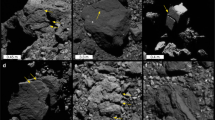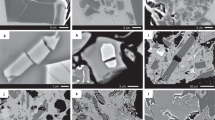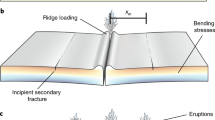Abstract
On asteroids, fractures develop due to stresses driven by diurnal temperature variations at spatial scales ranging from sub-millimetres to metres. However, the timescales of such rock fracturing by thermal fatigue are poorly constrained by observations. Here we analyse images of the asteroid (101955) Bennu obtained by the Origins, Spectral Interpretation, Resource Identification and Security-Regolith Explorer (OSIRIS-REx) mission and show that metre-scale fractures on the boulders exposed at the surface have a preferential meridional orientation, consistent with cracking induced by diurnal temperature variations. Using an analytical model of fracture propagation, we suggest that fractures the length of those on Bennu’s boulders can be produced in 104–105 years. This is a comparable or shorter timescale than mass movement processes that act to expose fresh surfaces and reorient boulders and any preferential direction signature. We propose that boulder surface fracturing happens rapidly compared with the lifetime in near-Earth space of Bennu and other carbonaceous asteroids. The damage due to this space-weathering process has consequences for the material properties of these asteroids, with implications for the preservation of the primordial signature acquired during the accretional phases in the protoplanetary disk of our solar system.
This is a preview of subscription content, access via your institution
Access options
Access Nature and 54 other Nature Portfolio journals
Get Nature+, our best-value online-access subscription
$29.99 / 30 days
cancel any time
Subscribe to this journal
Receive 12 print issues and online access
$259.00 per year
only $21.58 per issue
Buy this article
- Purchase on Springer Link
- Instant access to full article PDF
Prices may be subject to local taxes which are calculated during checkout



Similar content being viewed by others
Data availability
Raw and calibrated OCAMS images and OLA ancillary data are available via the Planetary Data System of NASA at sbn.psi.edu/pds/resource/orex/: refs. 49,50. The OLA v20 shape model is available via the Small Body Mapping Tool at sbmt.jhuapl.edu/. The image mosaics used in this study are available from refs. 20,41. Mosaic-FB3, mosaic-FB1, their respective .wcs files for SAOImageDS9 and the fracture files (SAOImageDS9 regions file) are available at https://doi.org/10.5281/zenodo.6373668. Source data are provided with this paper.
Code availability
Fracture mapping was performed using the astronomical image display and visualization tool ‘SAOImageDS9’ software, which is available at cfa.harvard.edu/saoimageds9, and also using the XPA messaging system (http://hea-www.harvard.edu/RD/xpa/index.html). Codes to map fractures, calculate and plot their orientations and compute the fracture propagations are available at https://doi.org/10.5281/zenodo.6373668. The latter dataset also includes imaging mosaics FB1 and FB3 from their respective references.
References
Lauretta, D. S. et al. The OSIRIS-REx target asteroid (101955) Bennu: constraints on its physical, geological, and dynamical nature from astronomical observations. Meteorit. Planet. Sci. 50, 834–849 (2015).
Simon, A. A. et al. Widespread carbon-bearing materials on near-Earth asteroid (101955) Bennu. Science 370, abs3522 (2020).
Hamilton, V. E. et al. Evidence for widespread hydrated minerals on asteroid (101955) Bennu. Nat. Astron. 3, 332–340 (2019).
Lauretta, D. S. et al. The unexpected surface of asteroid (101955) Bennu. Nature 568, 55–60 (2019).
Lauretta, D. S., Enons, H. L., Polit, A. T., Roper, H. L. & Wolner, C. W. V. in Sample Return Missions: The Last Frontier of Solar System Exploration (ed Longobardo, A.) Ch. 8 (Elsevier, 2021).
Michel, P. et al. Collisional formation of top-shaped asteroids and implications for the origins of Ryugu and Bennu. Nat. Commun. 11, 2655 (2020).
DellaGiustina, D. N. et al. Variations in color and reflectance on the surface of asteroid (101955) Bennu. Science 370, eabc3660 (2020).
Delbo, M. et al. Thermal fatigue as the origin of regolith on small asteroids. Nature 508, 233–236 (2014).
Molaro, J. L., Byrne, S. & Le, J. L. Thermally induced stresses in boulders on airless body surfaces, and implications for rock breakdown. Icarus 294, 247–261 (2017).
Molaro, J. L. et al. In situ evidence of thermally induced rock breakdown widespread on Bennu’s surface. Nat. Commun. 11, 2913 (2020).
Rozitis, B. et al. Asteroid (101955) Bennu’s weak boulders and thermally anomalous Equator. Sci. Adv. 6, 41 (2020).
McFadden, L. D., Eppes, M. C., Gillespie, A. R. & Hallet, B. Physical weathering in arid landscapes due to diurnal variation in the direction of solar heating. Geol. Soc. Am. Bull. 117, 161–173 (2005).
Eppes, M.-C., Willis, A., Molaro, J., Abernathy, S. & Zhou, B. Cracks in Martian boulders exhibit preferred orientations that point to solar-induced thermal stress. Nat. Commun. 6, 6712 (2015).
Sugita, S. et al. The geomorphology, color, and thermal properties of Ryugu: implications for parent-body processes. Science 364, 252–252 (2019).
Walsh, K. J. et al. Craters, boulders and regolith of (101955) Bennu indicative of an old and dynamic surface. Nat. Geosci.12, 242–246 (2019).
Uribe-Suárez, D., Delbo, M., Bouchard, P. O. & Pino-Muñoz, D. Diurnal temperature variation as the source of the preferential direction of fractures on asteroids: theoretical model for the case of Bennu. Icarus 360, 114347 (2021).
Molaro, J. L. et al. Thermal fatigue as a driving mechanism for activity on asteroid Bennu. J. Geophys. Res. Planets 125, e06325 (2020).
El Mir, C., Ramesh, K. T. & Delbo, M. The efficiency of thermal fatigue in regolith generation on small airless bodies. Icarus 333, 356–370 (2019).
Ravaji, B., Ali-Lagoa, V., Delbo, M. & Wilkerson, J. W. Unraveling the mechanics of thermal stress weathering: rate-effects, size-effects, and scaling laws. J. Geophys. Res. Planets 124, 3304–3328 (2019).
Bennett, C. A. et al. A high-resolution global basemap of (101955) Bennu. Icarus 357, 113690 (2021).
Rizk, B. et al. OCAMS: the OSIRIS-REx camera suite. Space Sci. Rev. 214, 26 (2018).
DellaGiustina, D. N. et al. Properties of rubble-pile asteroid (101955) Bennu from OSIRIS-REx imaging and thermal analysis. Nat. Astron. 3, 341–351 (2019).
Attree, N. et al. Thermal fracturing on comets. Applications to 67P/Churyumov–Gerasimenko. Astron. Astrophys. 610, A76 (2018).
Ragan, D. M. Structural Geology. An Introduction to Geometrical Techniques 4th edn (Cambridge Univ. Press, 2009).
Matonti, C. et al. Bilobate comet morphology and internal structure controlled by shear deformation. Nat. Geosci. 12, 157–162 (2019).
Giuffrida, A. et al. Fracture simulation parameters of fractured reservoirs: analogy with outcropping carbonates of the Inner Apulian Platform, southern Italy. J. Struct. Geol. 123, 18–41 (2019).
Ballouz, R. L. et al. Bennu’s near-Earth lifetime of 1.75 million years inferred from craters on its boulders. Nature 587, 205–209 (2020).
Hörz, F., Basilevsky, A. T., Head, J. W. & Cintala, M. J. Erosion of lunar surface rocks by impact processes: a synthesis. Planet. Space Sci. 194, 105105 (2020).
Avdellidou, C. et al. Very weak carbonaceous asteroid simulants I: mechanical properties and response to hypervelocity impacts. Icarus 341, 113648 (2020).
Jawin, E. R. et al. Global patterns of recent mass movement on asteroid (101955) Bennu. J. Geophys. Res. Planets 125, 501–521 (2020).
Libourel, G. et al. Network of thermal cracks in meteorites due to temperature variations: new experimental evidence and implications for asteroid surfaces. Mon. Notices R. Astron. Soc. 500, 1905–1920 (2021).
Hasselman, D. Effect of cracks on thermal conductivity. J. Compos. Mater. 12, 403–407 (1978).
Grott, M. et al. Low thermal conductivity boulder with high porosity identified on C-type asteroid (162173) Ryugu. Nat. Astron. 3, 971–976 (2019).
Okada, T. et al. Highly porous nature of a primitive asteroid revealed by thermal imaging. Nature 579, 518–522 (2020).
Shimaki, Y. et al. Thermophysical properties of the surface of asteroid 162173 Ryugu: infrared observations and thermal inertia mapping. Icarus 348, 113835 (2020).
Hörz, F. & Cintala, M. Impact experiments related to the evolution of planetary regoliths. Meteorit. Planet. Sci. 32, 179–209 (1997).
Lauretta, D. S. et al. Episodes of particle ejection from the surface of the active asteroid (101955) Bennu. Science 366, eaay3544 (2019).
Granvik, M. et al. Super-catastrophic disruption of asteroids at small perihelion distances. Nature 530, 303–306 (2016).
Melikyan, R. E. et al. Bennu’s natural sample delivery mechanism: estimating the flux of Bennuid meteors at Earth. J. Geophys. Res. Planets 126, e06817 (2021).
Cambioni, S. et al. Fine-regolith production on asteroids controlled by rock porosity. Nature 598, 49–52 (2021).
Golish, D. R. et al. Disk-resolved photometric modeling and properties of asteroid (101955) Bennu. Icarus 357, 113724 (2021).
Daly, M. G. et al. Hemispherical differences in the shape and topography of asteroid (101955) Bennu. Sci. Adv. 6, eabd3649 (2020).
Bonnet, E. et al. Scaling of fracture systems in geological media. Rev. Geophys. 39, 347–383 (2001).
Delbo, M. & Michel, P. Temperature history and dynamical evolution of (101955) 1999 RQ 36: a potential target for sample return from a primitive asteroid. Astrophys. J. Lett. 728, L42 (2011).
Rooke, D. P. & Cartwright, D. J. Compendium of Stress Intensity Factors (Great Britain Ministry of Defence, Procurement Executive, 1976).
Ibrahim, M. I. The Elastic Properties of Carbonaceous Chondrites. MSc Thesis, Univ. Calgary (2012).
Bryson, K. L., Ostrowski, D. R. & Blasizzo, A. Meteorite flaws and scaling for atmospheric entry. Plant. Space Sci. 164, 85–90 (2018).
Opeil, C. P., Britt, D. T., Macke, R. J. & Consolmagno, G. J. The surprising thermal properties of CM carbonaceous chondrites. Meteorit. Planet. Sci. 55, E1–E20 (2020).
Rizk, B., Drouet d’Aubigny, C., Golish, D., DellaGiustina, D. N. & Lauretta, D. S. Origins, Spectral Interpretation, Resource Identification, Security, Regolith Explorer (OSIRIS-REx): OSIRIS-REx Camera Suite (OCAMS) Bundle. NASA Planetary Data System https://arcnav.psi.edu/urn:nasa:pds:orex.ocams (2019).
Daly, M., Barnouin, O., Espiritu, R. & Lauretta, D. S. Origins, Spectral Interpretation, Resource Identification, Security, Regolith Explorer (OSIRIS-REx): OSIRIS-REx Laser Altimeter Bundle. NASA Planetary Data System https://arcnav.psi.edu/urn:nasa:pds:orex.ola (2019).
Acknowledgements
This material is based on work supported by NASA under contract NNM10AA11C issued through the New Frontiers Program. We are grateful to the entire OSIRIS-REx team for making the encounter with Bennu possible, to C. Wolner for editorial help and to the OPAL infrastructure of the Observatoire de la Côte d’Azur (CRIMSON) for providing computational resources and support. M.D. and C.A. acknowledge the French space agency CNES and support from ANR ‘ORIGINS’ (ANR-18-CE31-0014). M.P. was supported for this research by the Italian Space Agency (ASI) under the ASI-INAF agreement number 2017-37-H.0. S.R.S. was supported by grant number 80NSSC18K0226 as part of the OSIRIS-REx Participating Scientist Program. We thank D. Durda for useful comments that improved our manuscript.
Author information
Authors and Affiliations
Contributions
M.D. led the project, the interpretation of the results and the development of the manuscript. M.D., M.P. and M.M.A.A. mapped fractures; K.J.W. compared the independent fracture mapping. C.M. contributed to the interpretation of fractures. J.W. and M.D. developed the thermal-fatigue fracture-mechanics model, which was discussed and improved by J.L.M. D.N.D.G., C.B. and D.R.G. provided image processing support. M.D. and K.J.W. wrote codes for the analysis. C.A., R-L.B., H.C.C., C.A.B., D.N.D.G., D.R.G., J.L.M., B.R., S.R.S. and K.J.W. provided support in the interpretation of spacecraft imagery. C.A. and R-L.B. helped with comparison against impact-driven fractures. K.J.W. and B.R. contributed to the data interpretation during the OSIRIS-REx Regolith Development Working Group (RDWG) and Image Processing Working Group (IPWG) meetings and to design of the observations and data acquisition. K.J.W. and D.N.D.G. led the RDWG and the IPWG, respectively. D.S.L. made this study possible as the principal investigator of the OSIRIS-REx mission and contributed to the discussion of the results. M.D., C.M. and K.J.W. wrote the manuscript with contribution of text, figures, equations and discussions from all co-authors.
Corresponding author
Ethics declarations
Competing interests
The authors declare no competing interests.
Peer review
Peer review information
Primary handling editors: Tamara Goldin and James Super, in collaboration with the Nature Geoscience team. Nature Geoscience thanks Daniel Durda, Jean-Baptiste Vincent and the other, anonymous, reviewer(s) for their contribution to the peer review of this work.
Additional information
Publisher’s note Springer Nature remains neutral with regard to jurisdictional claims in published maps and institutional affiliations.
Extended data
Extended Data Fig. 1 Examples of different fracture morphologies.
As Fig. 1 but without the red poly-lines resulting from fracture mapping.
Extended Data Fig. 2 Global fracture distribution on the mosaic of images obtained on 2019- 03-21 by OSIRIS-REx.
This mosaic shows the surface of Bennu between 0 and 360o of longitude and -70o and 70o of latitude from ref. 20. The red lines represent the fractures that we mapped. The blue horizontal lines at latitudes of -50o, -15o, 15o, and 50o mark the boundaries of the southern mid-latitude, equatorial, and northern mid-latitude bands for which the directions and the abundance of the fractures are reported in this study (see Figs. 2, 3 and Extended Data Fig. 6).
Extended Data Fig. 3 Verification of fracture identification by higher-spatial- resolution images and independent mapping.
Fractures (red) mapped on Mosaic-FB3 (a) and (b) on a higher-resolution (4 cm pixel−1) mosaic from the Reconnaissance-A flyover of Osprey5 (October 12, 2019; phase angle of 41o). The longer fracture on the largest boulder mapped in (a) is confirmed in (b). Small fractures (red arrows) in (b) cannot be seen in (a) and thus were not mapped. In (c) and (d) green rectangles delimit two of the seven areas of the independent fracture mapping. Yellow arrows indicate fractures mapped in both mapping. Red arrows indicate fractures only identified in the nominal mapping.
Extended Data Fig. 4 Histogram of the V-band normal reflectance of boulders and boulders with fractures.
Extended Data Fig. 5 Windrose diagram of fractures’ azimuth in low- and high-boulder density regions and where a second fracture identification was performed.
In (a), black- and grey-lined rectangles show, respectively, the regions of high and low boulder density, according to Fig. 2 of ref. 15 where the corresponding windrose diagrams of fractures’ azimuth where calculated (displayed on the right side of each area). (b) Map of the seven rectangular regions within which a second co-author performed an independent fracture identification and mapping. The windrose diagram of the azimuth of the fractures mapped in all areas is overlaid on top of the background map.
Extended Data Fig. 6 Windrose histograms of the azimuthal direction of fractures and fracture segments normalised to the number of boulders.
Extended Data Fig. 7 A benched impact crater on boulder.
(a) Image of a portion of a boulder located at 348o of longitude and -60o of latitude showing an impact crater and radial fractures (not mapped on Mosaic-FB3, because outside the -50o − 50o latitude range). Image ID is ocams20190328t203728s625 pol. (b) Depth vs. distance from crater centre profile, along the dashed line of panel (a) from point A to B, obtained from OLA scan 4252 using the method of ref. 27.
Extended Data Fig. 8 Model of a boulder with fracture.
The green boulder rests on Bennu’s equator and is partially buried in regolith (grey area). Its z-axis is along Bennu’s radius. All surfaces of the boulder are free to expand and contract in response to thermo-mechanical forcing. There is no thermal contact between the regolith and the boulder, a fair assumption as L, D ≫ ls, the latter being the typical distance of propagation of diurnal temperature variations. The fracture is represented by the shaded surface, which penetrates the boulder, from its surface downward (z+) towards the centre of Bennu, and laterally along the x+ and x- directions.
Extended Data Fig. 9 Modelling of the evolution of a length distribution of fractures.
The evolution as a function of time is displayed at different epochs for a set of surface fractures with an initially microscopic length distribution (curve at t = 0 kyr). The vertical slope of the t = 50 kyr and t = 100 kyr curves are very similar to the one measured for Bennu’s boulder fractures and displayed in Fig. 3. The thick-solid curve shows the size distribution of the boulders hosting the modelled fractures.
Source data
Source Data Fig. 2
Azimuth of fractures and fracture segments.
Source Data Fig. 3
Sorted lengths of fractures and fracture segments.
Source Data Extended Data Fig. 4
V-band normal reflectance of boulders and boulders with fractures.
Source Data Extended Data Fig. 5
Number of fractures per histogram bin of the independent fracture mapping.
Source Data Extended Data Fig. 6
Number of fractures and fracture segments per histogram bin in different latitudinal bands corrected for the number of boulders counted in the respective latitudinal band.
Source Data Extended Data Fig. 7
Height of the crater as a function of distance from its centre.
Source Data Extended Data Fig. 9
Simulated length of fractures using our model for different times and length of their hosting boulders.
Rights and permissions
About this article
Cite this article
Delbo, M., Walsh, K.J., Matonti, C. et al. Alignment of fractures on Bennu’s boulders indicative of rapid asteroid surface evolution. Nat. Geosci. 15, 453–457 (2022). https://doi.org/10.1038/s41561-022-00940-3
Received:
Accepted:
Published:
Issue Date:
DOI: https://doi.org/10.1038/s41561-022-00940-3
This article is cited by
-
Asteroid Kamo‘oalewa’s journey from the lunar Giordano Bruno crater to Earth 1:1 resonance
Nature Astronomy (2024)
-
A weak and active surface of Bennu
Nature Geoscience (2022)



